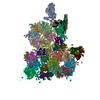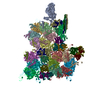[English] 日本語
 Yorodumi
Yorodumi- PDB-5zz8: Structure of the Herpes simplex virus type 2 C-capsid with capsid... -
+ Open data
Open data
- Basic information
Basic information
| Entry | Database: PDB / ID: 5zz8 | ||||||
|---|---|---|---|---|---|---|---|
| Title | Structure of the Herpes simplex virus type 2 C-capsid with capsid-vertex-specific component | ||||||
 Components Components |
| ||||||
 Keywords Keywords | STRUCTURAL PROTEIN / Herpes simplex virus 2 / capsid / capsid-vertex-specific component | ||||||
| Function / homology |  Function and homology information Function and homology informationdeNEDDylase activity / viral genome packaging / T=16 icosahedral viral capsid / viral tegument / viral capsid assembly / viral DNA genome replication / viral process / chromosome organization / viral penetration into host nucleus / viral capsid ...deNEDDylase activity / viral genome packaging / T=16 icosahedral viral capsid / viral tegument / viral capsid assembly / viral DNA genome replication / viral process / chromosome organization / viral penetration into host nucleus / viral capsid / host cell / symbiont-mediated perturbation of host ubiquitin-like protein modification / cysteine-type deubiquitinase activity / host cell cytoplasm / symbiont entry into host cell / host cell nucleus / structural molecule activity / proteolysis / DNA binding Similarity search - Function | ||||||
| Biological species |   Human herpesvirus 2 Human herpesvirus 2 | ||||||
| Method | ELECTRON MICROSCOPY / single particle reconstruction / cryo EM / Resolution: 3.75 Å | ||||||
 Authors Authors | Wang, J.L. / Yuan, S. / Zhu, D.J. / Tang, H. / Wang, N. / Chen, W.Y. / Gao, Q. / Li, Y.H. / Wang, J.Z. / Liu, H.R. ...Wang, J.L. / Yuan, S. / Zhu, D.J. / Tang, H. / Wang, N. / Chen, W.Y. / Gao, Q. / Li, Y.H. / Wang, J.Z. / Liu, H.R. / Zhang, X.Z. / Rao, Z.H. / Wang, X.X. | ||||||
 Citation Citation |  Journal: Nat Commun / Year: 2018 Journal: Nat Commun / Year: 2018Title: Structure of the herpes simplex virus type 2 C-capsid with capsid-vertex-specific component. Authors: Jialing Wang / Shuai Yuan / Dongjie Zhu / Hao Tang / Nan Wang / Wenyuan Chen / Qiang Gao / Yuhua Li / Junzhi Wang / Hongrong Liu / Xinzheng Zhang / Zihe Rao / Xiangxi Wang /  Abstract: Herpes simplex viruses (HSVs) cause human oral and genital ulcer diseases. Patients with HSV-2 have a higher risk of acquiring a human immunodeficiency virus infection. HSV-2 is a member of the α- ...Herpes simplex viruses (HSVs) cause human oral and genital ulcer diseases. Patients with HSV-2 have a higher risk of acquiring a human immunodeficiency virus infection. HSV-2 is a member of the α-herpesvirinae subfamily that together with the β- and γ-herpesvirinae subfamilies forms the Herpesviridae family. Here, we report the cryo-electron microscopy structure of the HSV-2 C-capsid with capsid-vertex-specific component (CVSC) that was determined at 3.75 Å using a block-based reconstruction strategy. We present atomic models of multiple conformers for the capsid proteins (VP5, VP23, VP19C, and VP26) and CVSC. Comparison of the HSV-2 homologs yields information about structural similarities and differences between the three herpesviruses sub-families and we identify α-herpesvirus-specific structural features. The hetero-pentameric CVSC, consisting of a UL17 monomer, a UL25 dimer and a UL36 dimer, is bound tightly by a five-helix bundle that forms extensive networks of subunit contacts with surrounding capsid proteins, which reinforce capsid stability. | ||||||
| History |
|
- Structure visualization
Structure visualization
| Movie |
 Movie viewer Movie viewer |
|---|---|
| Structure viewer | Molecule:  Molmil Molmil Jmol/JSmol Jmol/JSmol |
- Downloads & links
Downloads & links
- Download
Download
| PDBx/mmCIF format |  5zz8.cif.gz 5zz8.cif.gz | 4.8 MB | Display |  PDBx/mmCIF format PDBx/mmCIF format |
|---|---|---|---|---|
| PDB format |  pdb5zz8.ent.gz pdb5zz8.ent.gz | Display |  PDB format PDB format | |
| PDBx/mmJSON format |  5zz8.json.gz 5zz8.json.gz | Tree view |  PDBx/mmJSON format PDBx/mmJSON format | |
| Others |  Other downloads Other downloads |
-Validation report
| Summary document |  5zz8_validation.pdf.gz 5zz8_validation.pdf.gz | 1.3 MB | Display |  wwPDB validaton report wwPDB validaton report |
|---|---|---|---|---|
| Full document |  5zz8_full_validation.pdf.gz 5zz8_full_validation.pdf.gz | 1.4 MB | Display | |
| Data in XML |  5zz8_validation.xml.gz 5zz8_validation.xml.gz | 594.9 KB | Display | |
| Data in CIF |  5zz8_validation.cif.gz 5zz8_validation.cif.gz | 980.7 KB | Display | |
| Arichive directory |  https://data.pdbj.org/pub/pdb/validation_reports/zz/5zz8 https://data.pdbj.org/pub/pdb/validation_reports/zz/5zz8 ftp://data.pdbj.org/pub/pdb/validation_reports/zz/5zz8 ftp://data.pdbj.org/pub/pdb/validation_reports/zz/5zz8 | HTTPS FTP |
-Related structure data
| Related structure data |  6976MC M: map data used to model this data C: citing same article ( |
|---|---|
| Similar structure data | Similarity search - Function & homology  F&H Search F&H Search |
- Links
Links
- Assembly
Assembly
| Deposited unit | 
|
|---|---|
| 1 | x 60
|
| 2 |
|
| 3 | x 5
|
| 4 | x 6
|
| 5 | 
|
| Symmetry | Point symmetry: (Schoenflies symbol: I (icosahedral)) |
- Components
Components
-Protein , 7 types, 51 molecules QTW1wRSUVXY32xyIJKLMAHNOPBCDEF...
| #1: Protein | Mass: 50566.648 Da / Num. of mol.: 5 Source method: isolated from a genetically manipulated source Source: (gene. exp.)   Human herpesvirus 2 / Gene: UL38, TRX1 / Production host: Human herpesvirus 2 / Gene: UL38, TRX1 / Production host:  Chlorocebus sabaeus (green monkey) / References: UniProt: G9I260 Chlorocebus sabaeus (green monkey) / References: UniProt: G9I260#2: Protein | Mass: 34373.785 Da / Num. of mol.: 10 Source method: isolated from a genetically manipulated source Source: (gene. exp.)   Human herpesvirus 2 / Gene: TRX2, UL18 / Production host: Human herpesvirus 2 / Gene: TRX2, UL18 / Production host:  Chlorocebus sabaeus (green monkey) / References: UniProt: P89441 Chlorocebus sabaeus (green monkey) / References: UniProt: P89441#3: Protein | Mass: 149384.375 Da / Num. of mol.: 16 Source method: isolated from a genetically manipulated source Source: (gene. exp.)   Human herpesvirus 2 / Gene: UL19, MCP / Production host: Human herpesvirus 2 / Gene: UL19, MCP / Production host:  Chlorocebus sabaeus (green monkey) / References: UniProt: A0A0E3U2U0 Chlorocebus sabaeus (green monkey) / References: UniProt: A0A0E3U2U0#4: Protein | Mass: 12147.707 Da / Num. of mol.: 15 Source method: isolated from a genetically manipulated source Source: (gene. exp.)   Human herpesvirus 2 / Gene: SCP, UL35 / Production host: Human herpesvirus 2 / Gene: SCP, UL35 / Production host:  Chlorocebus sabaeus (green monkey) / References: UniProt: P89458 Chlorocebus sabaeus (green monkey) / References: UniProt: P89458#5: Protein | | Mass: 74747.805 Da / Num. of mol.: 1 Source method: isolated from a genetically manipulated source Source: (gene. exp.)   Human herpesvirus 2 / Gene: UL17, CVC1 / Production host: Human herpesvirus 2 / Gene: UL17, CVC1 / Production host:  Chlorocebus sabaeus (green monkey) / References: UniProt: G9I238 Chlorocebus sabaeus (green monkey) / References: UniProt: G9I238#6: Protein | Mass: 63623.836 Da / Num. of mol.: 2 Source method: isolated from a genetically manipulated source Source: (gene. exp.)   Human herpesvirus 2 / Gene: UL25, CVC2 / Production host: Human herpesvirus 2 / Gene: UL25, CVC2 / Production host:  Chlorocebus sabaeus (green monkey) / References: UniProt: D6PUY5 Chlorocebus sabaeus (green monkey) / References: UniProt: D6PUY5#7: Protein | Mass: 330616.156 Da / Num. of mol.: 2 Source method: isolated from a genetically manipulated source Source: (gene. exp.)   Human herpesvirus 2 / Gene: UL36 / Production host: Human herpesvirus 2 / Gene: UL36 / Production host:  Chlorocebus sabaeus (green monkey) / References: UniProt: A0A1U9ZLV0 Chlorocebus sabaeus (green monkey) / References: UniProt: A0A1U9ZLV0 |
|---|
-Details
| Has protein modification | Y |
|---|
-Experimental details
-Experiment
| Experiment | Method: ELECTRON MICROSCOPY |
|---|---|
| EM experiment | Aggregation state: PARTICLE / 3D reconstruction method: single particle reconstruction |
- Sample preparation
Sample preparation
| Component | Name: Human herpesvirus 2 / Type: VIRUS / Entity ID: all |
|---|---|
| Source (natural) | Organism:   Human herpesvirus 2 Human herpesvirus 2 |
| Source (recombinant) | Organism:  Chlorocebus sabaeus (green monkey) Chlorocebus sabaeus (green monkey) |
| Details of virus | Enveloped: NO / Isolate: STRAIN / Type: VIRION |
| Buffer solution | pH: 7.4 |
| Specimen | Embedding applied: NO / Shadowing applied: NO / Staining applied: NO / Vitrification applied: YES |
| Vitrification | Cryogen name: ETHANE |
- Electron microscopy imaging
Electron microscopy imaging
| Experimental equipment |  Model: Titan Krios / Image courtesy: FEI Company |
|---|---|
| Microscopy | Model: FEI TITAN KRIOS |
| Electron gun | Electron source:  FIELD EMISSION GUN / Accelerating voltage: 300 kV / Illumination mode: FLOOD BEAM FIELD EMISSION GUN / Accelerating voltage: 300 kV / Illumination mode: FLOOD BEAM |
| Electron lens | Mode: OTHER |
| Image recording | Electron dose: 30 e/Å2 / Film or detector model: GATAN K2 QUANTUM (4k x 4k) |
- Processing
Processing
| CTF correction | Type: NONE |
|---|---|
| Symmetry | Point symmetry: C1 (asymmetric) |
| 3D reconstruction | Resolution: 3.75 Å / Resolution method: FSC 0.143 CUT-OFF / Num. of particles: 56901 / Symmetry type: POINT |
 Movie
Movie Controller
Controller


 PDBj
PDBj
